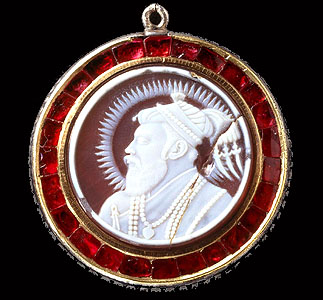
Jewelled Arts of India in the Age of the Mughals The Al-Sabah Collection 18 May - 2 September 2001 Fig.: Gold pendant set with rubies and chalcedony cameo portrait of Emperor Shah Jahan. Front, Mughal, 17th century, reverse, Deccan, 19th century. Height 4.22cm, diameter 3.34cm. © Bruce M. White
One of the highlights of the exhibition is the collection of relief-carved hardstones, including nine emeralds, ranging from 17 to 235 carats, imported from Colombia and carved by the most skilled Indian craftsmen. The al-Sabah collection includes a large number of gemstones with historical inscriptions and over twenty royally inscribed spinels will be displayed. The most exceptional of these is a 249.3 carat spinel ruby with six royal inscriptions, of which the earliest dates to the reign of the Timurid ruler, Ulugh Beg ( 1447-1449 ). This stone, known as the ¡Talisman of the Throne¢, was presented to the Emperor Jahangir in 1621 by the ambassadors of Shah ¡Abbas the Great of Iran, whose own name is also inscribed on the stone. A few months later Jahangir gave the stone to his son, the future Shah Jahan, and it was eventually inserted into the famous Peacock throne. Such pieces not only reveal the Mughals¢ love of jewels but also provide a dazzling introduction to the history of one of the wealthiest and greatest empires of Asia. Techniques will also be examined such as the characteristic Indian kundan method of setting stones in pure gold which is fused at room temperature; gold inlaying of hardstones and precious metals with hammered relief decoration; and enamelling.
|